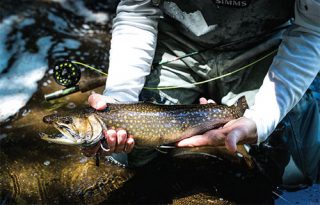

By Mark Usyk
The idea of a fly line forming graceful loops in the air over a piece of water on a warm day is the stuff fly anglers dream of three-hundred and sixty-five days a year, but never more so than once winter sets in. Once the temperatures drop, once the snow begins to fall, and, God help us as fly fishermen, once the waters begin to freeze over, we begin to torture ourselves with replaying the best days of the past summers over and over in our heads. The only thing that can be worse could be to begin to poor over maps, planning the next years explorations of streams and rivers, of lakes and ponds never fished before or never enough in the past, knowing that it’ll only serve to make the next few months drag on even slower. The only thing slower than a watched clock is a watched calendar.
Looking back, the 2016 spring through fall season was a good one for me. I caught some really nice fish. Not enough to make me believe that I honestly knew what I was doing to convince me I could catch them again, no probably not. But enough to make me realize that they are actually out there, that NY State truly has some spectacular waters to explore, and more so, if you put in some work, they can be found. Naturally a good amount of luck helps most of the time. And a lot of the time, if you make a thousand casts, there’s bound to be one or two nice fish in there somewhere. You can’t catch fish if you don’t have a line in the water.
I was fishing the West Canada Creek trophy section one morning this past summer with a small group of friends when I hooked into a gorgeous 21” brown. Now you have to understand things from my confusing and somewhat dizzying point of view. I hardly ever fish the West Canada because there are usually other fishermen, and I like fishing where no one else goes very often. I’d also gotten used to fishing the small streams of the Adirondacks, chasing brookies that averaged seven inches and became trophies around eleven. So here I was, fishing a river that only held stocked browns, and casting dry flies to rising fish, something I almost never do as a certified streamer junkie. Smitty had only given me the fly I was fishing a few moments earlier, and I was really making casts just to humor him. I didn’t believe for a moment that I’d actually catch the fish that had been rising, no, jumping, and crushing caddis flies thirty feet out from me for the past forty-five minutes. So when my cast ended with a decent drift over the right spot I took a deep breath when it disappeared with a splash and a roll of orange and tail fins.
Unlike the amazing 20” brook trout I’d hooked in a stream no more than twenty feet wide two weeks earlier, I let this brown charge upstream and down, flail and fight for every inch it took and lost, and never once worried about losing it simply because I never figured it was mine to catch in the first place. The large brookie two weeks earlier sent me into a panic from the onset. As soon as I saw it I couldn’t believe my eyes and never gave it a chance to fight. I was so afraid of losing it that I hauled it to the net with one hard tug, never considering the 6x tippet or thin 3wt rod could ever give up and fail at the worst moment in my life. In fact, I credit that catch only because I acted so fast. It’s my belief that the fish was in the net before either one of us truly knew what was happening. If the brookie had figured it out it surely would have turned and easily separated streamer from leader with its sharp teeth, and had I taken any longer to make a decision on how important of a fish the brookie was, I’d have surely fouled it up myself.
Now the best part of this, thinking about both these fish, the brown on the West Canada and the brookie in that Adirondack stream, is that they’re both waters that Trout Power is working to protect. It never hit me as to the importance of both these fish beyond the idea that I somehow managed to get them both in my net a couple weeks apart and then release them back to live another day. These fish prove that in both water sheds, there’s something worth fighting for, as there is for any waters you fish in all honesty.
Today you need to think about what you’re contributing to the fishery you’re spending your most precious time on in the coming days, and in the coming seasons. If you carry it in, carry it out. If you catch and release, handle the fish with care so that after released, they actually survive. If you keep fish, recognize that just because the state has set a limit for you on how many fish you can keep doesn’t mean that you should always take that limit. If you think about fish in your freezer vs fish in the lake or river, less means more in the end. And with today’s modern taxidermy, you don’t need to kill a trophy to bring it home for the wall. With good pictures and measurements, the fish can be released to live another day and a replica mount in great detail can fill that space on your wall. It’s the difference between being a fisherman, and being a good steward. If you don’t care about the being the latter, then why do you care about being the first? They relate to each other directly in the end.
